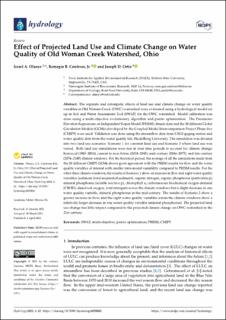| dc.description.abstract | The separate and synergistic effects of land use and climate change on water quality variables in Old Woman Creek (OWC) watershed were evaluated using a hydrological model set up in Soil and Water Assessment Tool (SWAT) for the OWC watershed. Model calibration was done using a multi-objective evolutionary algorithm and pareto optimization. The Parameter-Elevation Regressions on Independent Slopes Model (PRISM) climate data and the 20 different Global Circulation Models (GCMs) developed by the Coupled Model Intercomparison Project Phase five (CMIP5) were used. Validation was done using the streamflow data from USGS gaging station and water quality data from the water quality lab, Heidelberg University. The simulation was divided into two land use scenarios: Scenario 1 for constant land use and Scenario 2 where land use was varied. Both land use simulations were run in four time periods to account for climate change: historical (1985–2014), current to near future (2018–2045), mid-century (2046–2075), and late-century (2076–2100) climate windows. For the historical period, the average of all the simulations made from the 20 different CMIP5 GCMs shows good agreement with the PRISM results for flow and the water quality variables of interest with smaller inter-model variability compared to PRISM results. For the other three climate windows, the results of Scenario 1 show an increase in flow and eight water quality variables (sediment (total suspended sediment), organic nitrogen, organic phosphorus (particulate p), mineral phosphorus (soluble reactive p), chlorophyll a, carbonaceous biochemical oxygen demand (CBOD), dissolved oxygen, total nitrogen) across the climate windows but a slight decrease in one water quality variable, mineral phosphorus in the mid-century. The results of Scenario 2 show a greater increase in flow, and the eight water quality variables across the climate windows show a relatively larger decrease in one water quality variable (mineral phosphorus). The projected land use change has little impact compared to the projected climate change on OWC watershed in the 21st century. | en_US |

